Dear Artist,
“Never underestimate the power of the altered state,” said my Dad. While he avoided religion, he did enjoy cracking the door to his studio after a dinner party to catch a glimpse of his devotion through the ecstatic lens of a Côtes du Rhône. Seeing his work in the fully-baked half-light was, to him, a momentary indulgence in self-deception — a sight caught before the cold, clear light of dawn. No, to Dad, the altered state was not boozing while painting. Instead it meant, with the exception of those late-night visions, the natural high that happens when an artist achieves what Robert Henri called, his aliveness; when he becomes an “inventive, searching, daring, self-expressing creature.”
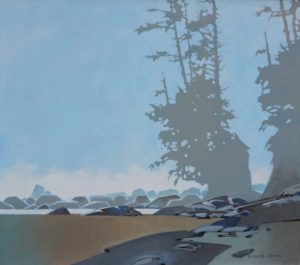
Sea Stack Pattern – Dare Beach on the West Coast Trail, 1996
30 x 34 inches
Acrylic on canvas
by Robert Genn (1936-2014)
How to get there? My Dad summoned his altered state by taking himself into heady, oxygen-rich environments by way of a brisk walk, paddle or tugboat steam; or a meandering drive, perhaps culminating in a local farmer’s winching of a bucolically-inappropriate vehicle from a bird-loud pasture. High altitudes were good, too, and mushroomed thickets. He sensed his subjects were hidden in these places, making themselves known only after he became dizzy enough to receive them. I saw him drunk on them, mid-75-kilometres, hiking on the shiny-wet, silvery strand of the West Coast Trail. His sea stacks hovered like mirages in the mist. Now, in my mind’s eye, I see them only as he painted them — they belonged to him, so. “An artist comes across the subject matter of his life only a handful of times,” he uttered, and dropped his pack. “The object isn’t to make art,” wrote Henri, “it’s to be in that wonderful state which makes art inevitable.”
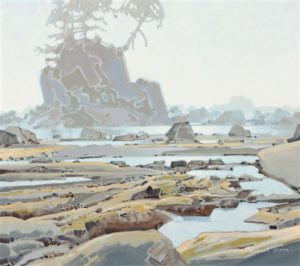
A Sea Stack on Carmanah Beach on the West Coast Trail, 1996
30 x 34 inches
Acrylic on canvas
by Robert Genn
And so what about the hard stuff? University of British Columbia professor of philosophy Edward Slingerland proposes that rather than simply being a vicey joy-ride, alcohol has served as an essential conduit for creativity. In fact, he thinks it’s basically responsible for modern civilization. Booze, says Slingerland, helped humans “become, at least temporarily, more creative, cultural, and communal” and “intoxicants provided the spark that allowed us to form truly large-scale groups.” Because it impairs the prefrontal cortex, the late-developing brain region in charge of abstract reasoning, behavior and focus, alcohol does have a lot to answer for. Psychologists at the University of California, Berkeley, and Yale have done studies suggesting that creativity in young children comes so easily precisely because of their glaringly undeveloped prefrontals. By temporarily disabling this part of the brain, drinking adults are merely trying to get back to the child-like state. In reasonable doses, a drink can be a social and stimulating thing. The key, as with any accelerant, is in the quantity and frequency and context of use.
Sincerely,
Sara
PS: “I get high on my work. Yep, it’s the work that lets you know you’re alive. It’s the work that makes you brilliant. It’s the work that gets you better and better. It’s the work that gets you silly.” (Robert Genn)
Esoterica: If Professor Slingerland is on to something, then which came first: the booze or the brilliance? I’ve always enjoyed, from a literary indulgence, the trope of each artform preferring its own intoxicant, and the accompanying lore of its use as a capturer of the muse, or as a dramatic cultivator of artistic tendencies. Do writers, for example, really prefer spirits and cigarettes, while rockers shoot up? Or maybe making art is just painful, and so, like previous civilization builders, we’re in need of a painkiller. Regardless, artists would do well to avoid practising the clichés of their heroes, lest they languish in their own, regurgitated clichés. Besides, I haven’t found absinthe to be a particularly interesting painting companion in 2021. A painter, afterall, should have a steady hand, and offer the world only her realness. For this reason alone, at least first try getting high by realizing your ideas. If the turps are making you dizzy, get some fresh air — your altered state — your state of awe — could be waiting for you out there.
Edward Sligerland’s 2021 exploration of civilization’s roots in alcohol, Drunk: How We Sipped, Danced, and Stumbled Our Way to Civilization is available here.
Have you considered a Premium Artist Listing? With each letter, an artist is featured at the bottom of this page. The Premium Artist Listings are a means of connecting artist subscribers through their work. Proceeds from each listing contribute to the production of The Painter’s Keys.
“You must stay drunk on [your art]so reality cannot destroy you.” (Ray Bradbury)
Featured Workshop
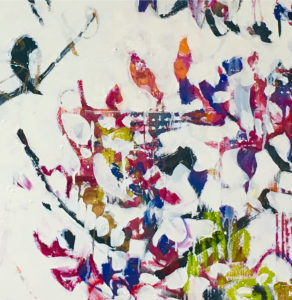 Join Ellie Harold for “Intuitive Painting: Permission to Paint Expressively,” designed especially for mature women artists of all skill levels who wish to explore this medium for soulful exploration. The retreat provides attractive accommodations (your own room!) along with lightly structured activities for centering, relaxation and low stress art-making. You’ll have plenty of free time to muse, paint, write and reflect while enjoying the colors, textures and flavors of San Miguel. This Retreat has the potential to transform not only your art but your life! You’ll return home with a specific art “care plan” to assure support for further creating. Details at www.EllieHarold.com.
Join Ellie Harold for “Intuitive Painting: Permission to Paint Expressively,” designed especially for mature women artists of all skill levels who wish to explore this medium for soulful exploration. The retreat provides attractive accommodations (your own room!) along with lightly structured activities for centering, relaxation and low stress art-making. You’ll have plenty of free time to muse, paint, write and reflect while enjoying the colors, textures and flavors of San Miguel. This Retreat has the potential to transform not only your art but your life! You’ll return home with a specific art “care plan” to assure support for further creating. Details at www.EllieHarold.com.
Featured Artist
We live in a fractured world. Wars, famine and power games are forcing people to abandon their homes and their way of life in hopes of finding peace. For lack of education or specialized skills, the poor are not accepted into our northern communities. They stay in the camps on the borders of turmoil, separated from local community. Animals are caught in the crossfire. Even the trees and the rocks suffer the agony of imbalance. This chaos is evident in my work. In between the rivulets of paint and the textural accidents I choose colours and forms to suggest a landscape where beauty continues to reign. We can still change the tide and build a new world harmony. Certainly, contemporary will focuses on gold instead of beauty. Yet, beauty is essential to the wellbeing of the planet. She is essential to the survival of humanity.

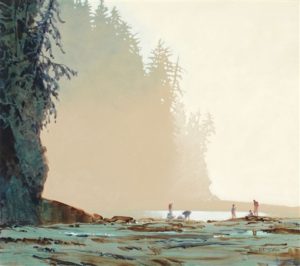
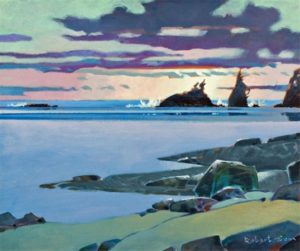
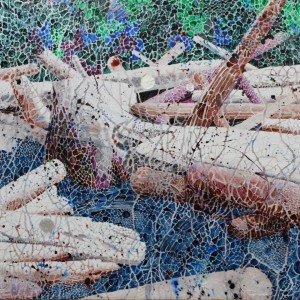



15 Comments
Wonderful, true words, Sara. Thank you.
Infrequently, I admit, I have found myself in a version of this “altered state.” When, at the end of a long, studio workday, while relaxing with a glass of Pinot, I have stepped away from the easel and experienced a real high. It feels as though, for a little while at least, I have been the medium. The colors and brush strokes have poured out of me, emanating from another place. The painting is real in a new way; more than the sum of its parts, tangible in ways I never expected. Granted, it doesn’t happen often, but when it does, it is pure magic and I wouldn’t trade that feeling for the world.
So easily we slip into our habits. Exercise has always been important for me. It tells me when I have had too much. I back off. I rest. Then a day or so later I crave that “high” once more. Meditating as I jump and stretch every muscle, I have a working painting placed nearby to glance at as I my blood rushes into my brain and gives me ideas for what to do next. Another important habit I love is a bath. Filling a tub with very hot water, salts, baking soda and submerging completely makes everything slow down. All electronics must be silenced. Relax for 20 minutes. Then I go to work, massaging my toes, fingers, scalp and scrub every bit of my skin. Alcohol is poison. Small amounts can be OK, but so many people abuse it. I think it is better to avoid it. The pancreas cries. The liver cries. We only need to listen. A product I have found helpful if you do decide to drink alcohol and you do not want a hangover is “Cheers”. It works well. It is scientifically formulated to help prevent the damage that the alcohol does. It works. I rarely drink wine. When I do it really affects me. I have found that if I take the product before bed, I do not have as bad of a hangover the next day. Science at its best! “Cheers!”
These paintings of your dads bring me into “altered stares”-Amazing and beautiful paintings that speak so eloquently the language of love for the landscape and his work. Thank you for sharing these and on childlike creativity.
Your Dad’s paintings are “ethereality”….I’ve been to those west coastal places that he captured so beautifully with his tools and talent. The act of creation is a heady altered state more potent than any libation….although a little help from “friends” can open otherwise closed doors.
Beautiful images of your father’s work – thanks for posting.
I call those rare unexpected times , my ” Tra La ” moments and uttered loudly and with feeling !
“Reaching the Zone” when my steps or art-making flows is the true altered state. When I run or walk or write or paint just long enough to reach the Zone of Flow, then intuition guides my seeing into stronger pattern-making and colour play.
The Zone of Flow is delight! I fall out eventually but what a pleasure while it lasts.
Thanks. Sara, for such a great follow up to your Dad’s letter re plein air and pattern making.
hmmmmmm…. really interesting read on the power of making art on our psychological make-up. I have often been amazed at the power of “mood” on everything I do. A low mood alters the intensity of colour, heightens my critical side into believing what I put on a canvas is boring and borderline crap. If I go to that same canvas in a good mood, the colours are glowing and I congratulate the person who painted it. How could this be the same painting I looked at in a low mood? I suspect this is an altered state kind of thing. The swings from highs to lows are something I can’t control. I can only control how I react to the crashes, don’t slash during a crash, leave it alone and go back and look at after a few sips of altered state. No wonder non-artists think we are eccentric and nuts. :) The paintings of your dad’s are exquisite, breathtaking!!
Today’s post has given me my first glance at these paintings by your father and only now can I begin to understand so much more. These are so delightful to the eye and thus to the spirit. Clearly, I am intoxicated by them.
“Do writers, for example, really prefer spirits and cigarettes, while rockers shoot up?” Seriously, Sara? What are you implying when you say “…while rockers shoot up.”? Your theme in this ‘essay’, nonetheless, is worthy of consideration. As a photographer, a musician and a writer, aged 72, I’ve known many creative people who are prone to ‘editing themselves’ or dismissing ideas before they are sufficiently evolved to take shape in their medium of choice. I’m no exception. It took me a very long time to acquire the habit of *not* being prematurely judgemental or dismissive of my own fresh ideas as they begin to emerge from my imagination and take shape by way of the dexterity of my hands. It’s been said: The best way to break habit is to make habit. Especially in these times, it’s human nature to overthink things. We live in an increasingly complex and complicated world where we are constantly distracted. Meanwhile, as we age, we lose the ability to distract ourselves. Children are remarkable in their ability to do precisely that. As a writer and photographer, I’ve acquired the habit of listening to Radio while I work. Classical music, exclusively. Not Opera. Not knowing what might be played next is practically essential to the strategy. It simply gives me something to focus on, partially, while my imagination struggles to deliver itself to realization. As for your image of “rockers shooting up”, it’s a cliche that has no place these days and is hopelessly outdated. Go figure.
Can we imagine how much better the world might be without it?
I was a bit surprised, yet thrilled, to read this! My work (watercolor landscape) is significantly influenced by my altered state as I hike or cycle through the landscape. When I talk (or write) about this, I seem to get a blank stare from listeners, or the equivalent from readers. I’ve yet to have many people ‘get it’ – that hiking the entire Pacific Crest Trail, Continental Divide Trail, off trail through out the Sierra, Cascades and Rockies could be such an intense endeavor as to bring about an altered state. Seemingly cycling across Europe, the US, Canada, the Baja Peninsula, New Zealand or the Australian continent doesn’t quite register as life changing and mind altering to others. I view the endorphins as a drug like any other – maybe not as unhealthy though. It certainly qualifies for me as ‘aliveness’ or as your quote aptly states: becoming an “inventive, searching, daring, self-expressing creature.” I call it moving meditation – which I guess could also be viewed as a spiritual experience, if not quite religious. Thanks again, Sara.
I looked up the West Coast Trail. Sounds like an arduous back packing trail, 75 km long. The paintings you posted with this article are quite large to have been packed all the way along that trail. Did your Dad work from photos for those paintings, or paint smaller sketches along the way?
Hi David,
He used photo reference…these paintings were made in his studio.
Warmest Regards,
Sara
I gave up booze, cigarettes, and drugs years ago. If I’m addicted to anything, it’s regular hard physical exercise, a lifelong habit for a man now in his 80s. As for my artwork – mainly woodcuts, encaustic collages, and journal making these days – the only altered state of mind I experience is a heightened state of concentration on what I am doing that keeps distractions at bay and makes the work flow. It’s mainly at other times, say when walking or doing chores, that random thoughts and ideas about my art come to mind, ideas that I can visualize and incorporate into artwork.
I really enjoyed seeing these subtle and poetic colours in your father’s paintings, Sara. and to feel the suffused light and mood of them
I am not familiar with the grandeur etc of Canada and America and thought his paintings of such places were too strong for me. So lovely to see Robert’s ‘ different’ work.. more a colourist in the last three.!
I hope it’s ok to have and express reservations which are more than outweighed by his recurring wisdom and encouragement and straight yet kind talking to us